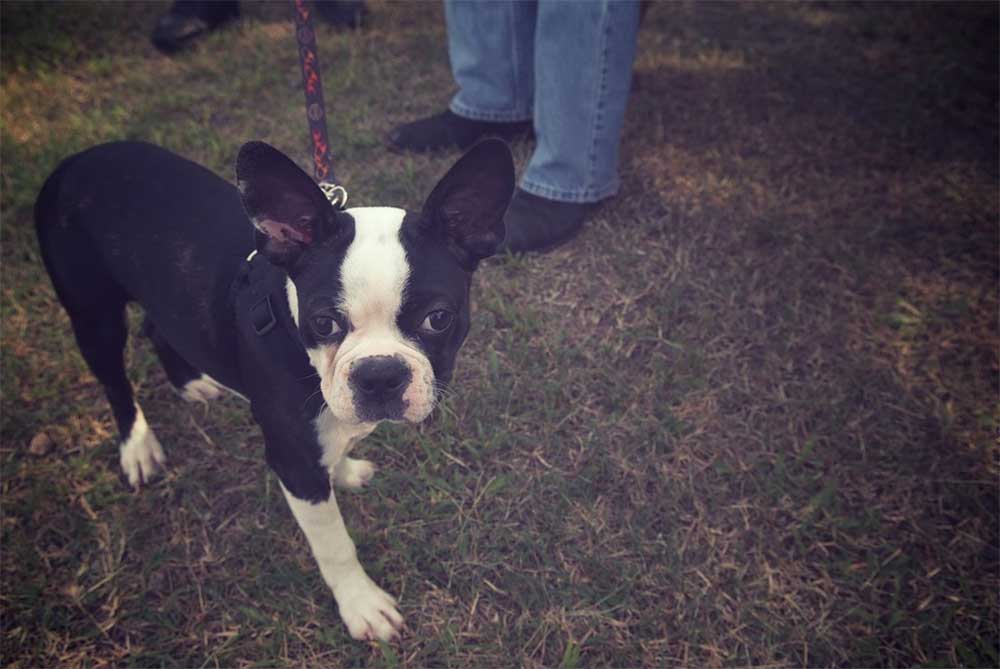As an athletic dog breed, Boston Terriers can be hard to control on their leashes if they haven’t had the proper training. With that in mind, how do you train a Boston Terrier to walk on a leash?
Like with any training, it’s best to start when the dogs are young. That doesn’t mean you can’t teach an adult Boston Terrier, however, but it’ll require more patience on your part. Adults have bad habits that need to be broken while puppies don’t, so you make more progress in less time.

Let’s take the training process step by step:
- First, you need to have the right location. The place needs few distractions and a lot of space for your dog to walk around and not get bored. Your backyard may be big enough, or a large field nearby, and even your hallway could work. Your Terrier should be comfortable in this space.
- You need to get a suitable leash that you can use. Some Boston Terriers have issues with eye-bulging if they pull on leashes too much, so a body harness can also work. Use the front ring of the leash harness, giving your dog too much leniency can encourage your pet to pull.
- Hold the leash in your dominant hand and the treats in your non-dominant one. You can swap the arrangement if you want the dog to walk on the opposite side for whatever reason.
- Your dog will move around freely. If they pull before you start walking, don’t walk with them or pull them back. Instead, simply wait for them to get the message and come back to you without any input on your part. Once they come back, give them a treat and make sure they notice it, and a nice pat on the head for good measure. Place it on the side you want the dog to walk.
- Your dog will eat the treat and, if they stay where they are, you should step forward. If they try to go beyond the reach of the leash again, simply repeat step four. If they stay, drop another treat. Rewards will be given generously at the beginning, so make sure you have enough!
- Your dog will become more consistent with the process as it repeats. If they’ve learned to stay in place, walk three steps and then give another treat but start pulling back gradually. If the dog loses interest and pulls, wait for them to come back and reward them yet again. After a few sessions, they should walk beside you consistently, at which point you’ve taught your Terrier to walk on its leash! Now you can graduate to an area with more distractions until the dog is comfortable there, and then you can slowly take it to the streets.
Patience is key when training your Boston Terrier to walk on its leash. It’s all about baby steps. Moving your dog too fast is a recipe for failure. Once the dog is able to be walked in public then you’ll have completed your Terrier’s leash training.
Here are some other tips you can use during the training sessions:
- Training sessions should be short, five to ten minutes long. Younger dogs have shorter attention spans, so keep that in mind when training a pup.
- The treats might get boring for your dog if you’re using the same ones. That’s why they’re “treats” and not just snacks. Change it up and choose treats that you know your dog loves!
- If you become frustrated, end the session. You don’t want to get yourself in a bad mood, and it’ll harm your dog if you do. Ask your dog for something that they can do, like sitting down, and then reward them for that. This way both you and your dog end the session on a good note.
Are Boston Terriers Good Off Leash?

Many proud dog owners love to let their dogs off the leash to give them some freedom, but is this viable for Boston Terriers? Boston Terriers can be trained to walk with you off-leash. Off-leash walking is trained just like on-leash walking is, albeit without the use of a leash. When training them, don’t walk in an area without a fence as this can be dangerous. You don’t want your dog to get distracted and run away, where it could get lost or hurt.
Needless to say, your dog should also be adequately trained with recall training before you even attempt off-leash walking or letting them off the leash for some playtime in a field. Your dog also shouldn’t be aggressive at strangers and other dogs and, if other dogs are nearby, you should be able to recall your Terrier and pick them up for their own safety.
